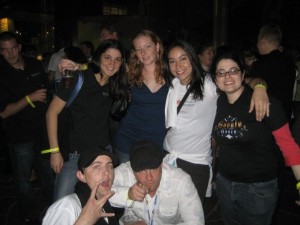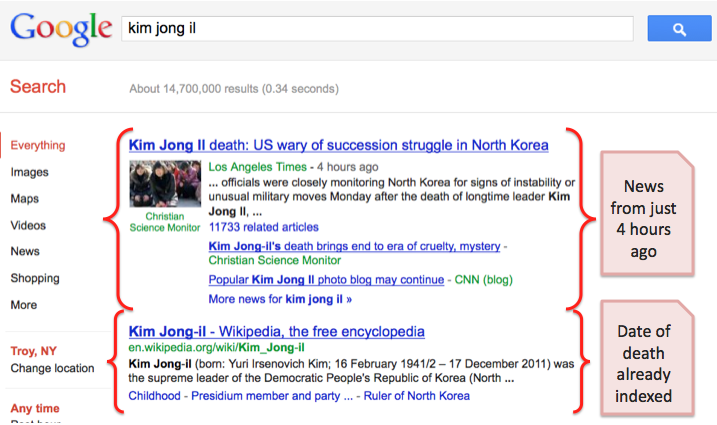
juice
bomb
dance
jagger
sandbox
panda
What do these words have in common?
If you answered “Google” you’ve gotten into the spirit of the 12 Days of SEO! And, when you feel the spirit coming on, there’s nothing to do but DANCE. So, on the 9th day of SEO, this lady is dancing to Christmas in Hollis and thinking about a different kind of dance — the Google Dance.
No, not the official Google Dance (see pic above) that used to be held annually at the Googleplex, though, those were fun and fortuitous.
The Google Dance I’m talking about is what used to happen in the search results whenever Google would update its index.
The Google Dance is the time period it takes for Google to update its search results. For luddites like myself, imagine trying to move from one city to another with a single pickup truck (your new apartment represents all of Google’s data centers where they store THE ENTIRE WORLD WIDE WEB! Well, what they can see of it). It’s unlikely that you’ll be able to move everything in one trip, because moving all that stuff to a couple locations will take time and several trips before you’ve got everything in your swanky new pad.
It’s the same thing with Google. Indexing the ENTIRE web used to take a lot of time and work to maintain. When they did an update to the search results, it would take a little while for those updates to “roll out” to all of the Google’s indices. It would take several days for the changes to appear across all of the different servers and this usually only happened once a month along with a big update.
The old school Google Dance updates used to represent a big change to the search results because they happened so infrequently and were packed with every algorithm update from that month. This meant that when major updates hit, they became major events in the life of a webmaster or SEO. Updates like Florida, Jagger and Mayday, and most recently, Panda. To track those updates, check out SEOmoz’s Google Algorithm Change History or Level343’s Google update infographic.
Tracking a Google Dance used to be super important because it gave SEOs a form of early diagnosis. I could get a “sneak peek” of a positive, negative or potentially disastrous update. I remember using SEO Chat to check multiple data centers for changes. I could type in a keyword and they would show me the search results from different, known servers. This would show me how far the change had progressed and what the results looked like. As an early warning system, it was invaluable.
These days it’s less common for people to talk about a “Google Dance” in the true sense of the phrase because the indices update daily rather than monthly. Since 2003, these daily, incremental updates have also allowed Google’s search results to more quickly incorporate algorithm updates and fresh content for queries that deserve freshness (QDF). This means that these days, we don’t have to track servers to see how long it will take for notice of Kim Jong-Il’s death to propagate to the web, it happens in minutes:

But Panda is an update that took place after the new, daily updates from Google and we still spend a lot of time tracking major and minor Panda updates. These updates are less focused on individual servers and more about sorting through the latest changes to the algorithm. In my mind the Google Dance still exists, it’s just so fast and personalized that it’s less important for us to track unless we’re deciphering data center localization. Panda was the exception, not the norm.
What does a Google Dance mean in today’s world?
To me, it means that search results can’t be guaranteed. As an agency or SEO consultant, make sure your contracts reflect that. And, as an in-house marketer or executive, manage the expectations of your team.
The latter really matters to me because I hate to see big puppy dog eyes from Danika when the awesome results she saw yesterday suddenly bounce back to the prior day’s search results. It’s demoralizing to someone who is working their butt off to affect change. So, help them out. Give them the history of the Google Dance and explain that even though things bounce around, it happens much faster than it used to and we’re looking for long-term results.
Think like your financial advisor:
- The only constant is change.
- If you focus on the minutiae, you will get lost. Focus instead on a long-term, positive investment.
- Be conservative if you can’t afford the risk.
- DIVERSIFY! Do not invest in one form of link development or one marketing channel. Insulate yourself from major updates.
- Educate your client and manage their expectations.
And that’s my history lesson for the day because when I think of ladies dancing my nerd brain instantly floats to Google. To have some fun, share your favorite Google Dance memories in the comments! The party or the SERP changes. :)
[This post is part of our 12 Days of SEO series where we’ll be publishing a different nugget of knowledge related to the sounds of the season. We’ll be updating the 12 Days of SEO page as new posts are published.]


